Navigation: Hankeys of Churton > John Hankey > Robert Hankey > Robert Hanky > Thomas Hankey > Henry Hankey > Thomas Hankey > Thomas Hankey > John Barnard Hankey > George James Barnard Hankey >
John Barnard Hankey (1845-1914)
Only son of George Barnard Hankey and his wife Andalusia, Barnard was born on 21 Apr 1845 at Fetcham Park and baptised on 23 Jun at Fetcham.
He was educated at Eton and Merton College, Oxford.
He was married on 27 Apr 1872 to Fanny Helen Pratt Barlow (1846-1886), daughter of Frederick Pratt Barlow (a paper manufacturer, of John Dickinson & Co Ltd).
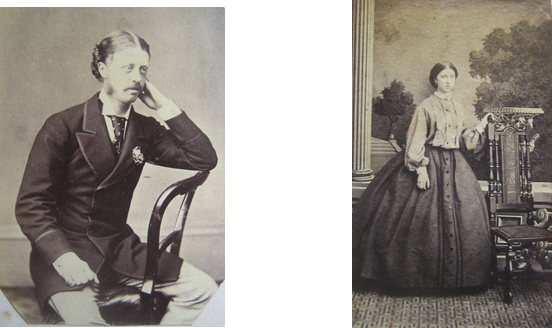
John Barnard Hankey and Fanny Pratt Barlow
in 1862, aged 16
Barnard and Fanny had three sons and three daughters:
George Frederick Barnard |
1873-1949 |
m 1900 Olive Sturgis (see below) |
Dorothea |
1874-1963 |
m 1896 Louis Paine, a stock broker; issue |
Edward Barnard |
1875-1959 |
m 1908 Katherine Dohan (see below) |
Mary Andalusia |
1877-1970 |
m 1898 Rev Cecil Graham Moon (1867-1948), brother of her step-mother; issue |
Cicily Elizabeth Barnard |
1881- |
m 1909 John WB White; issue |
Francis James Barnard |
1886-1942 |
m 1915 Anna Norris; issue. Major, MC. Of Montreal |
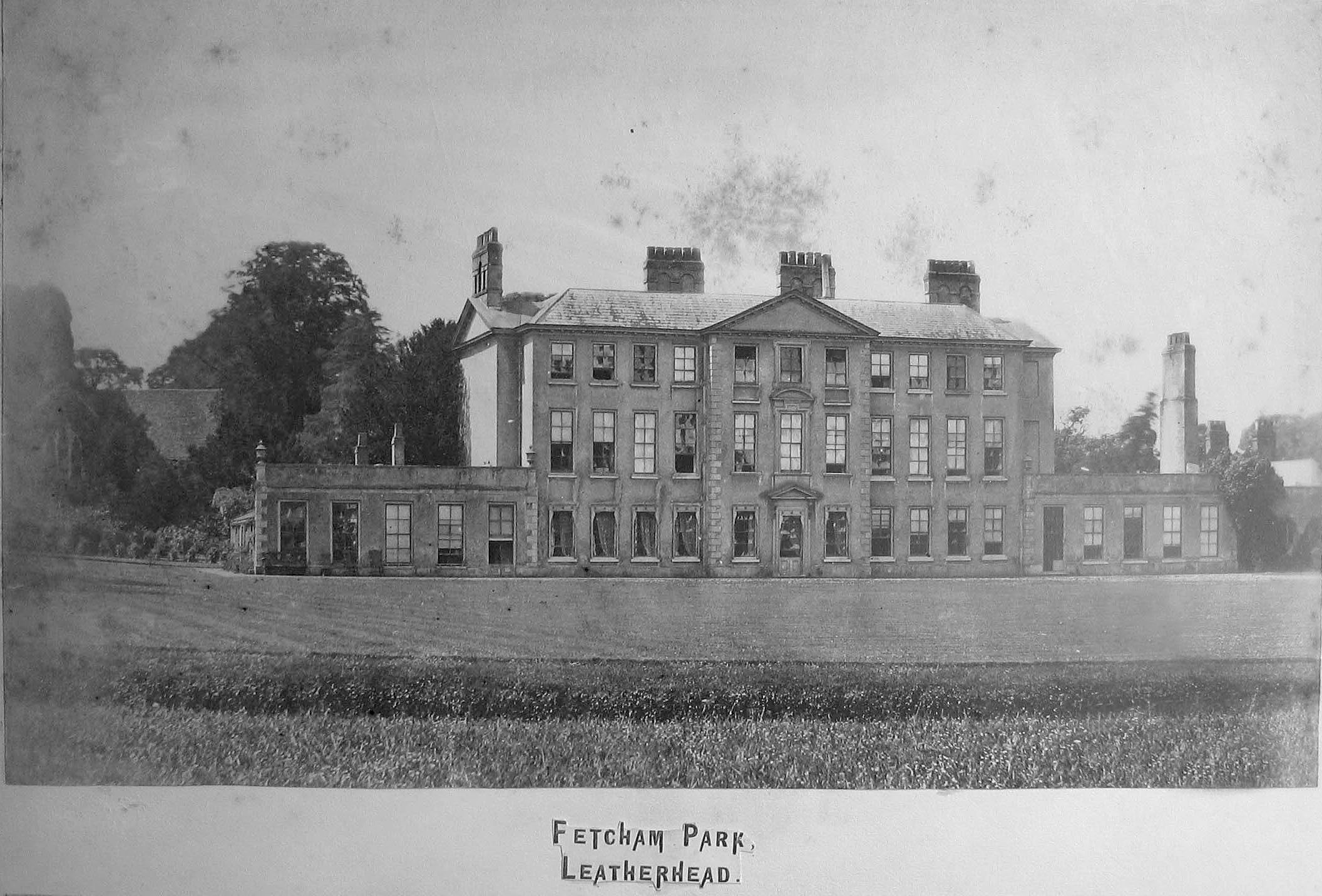
Fetcham Park (east) c.1876
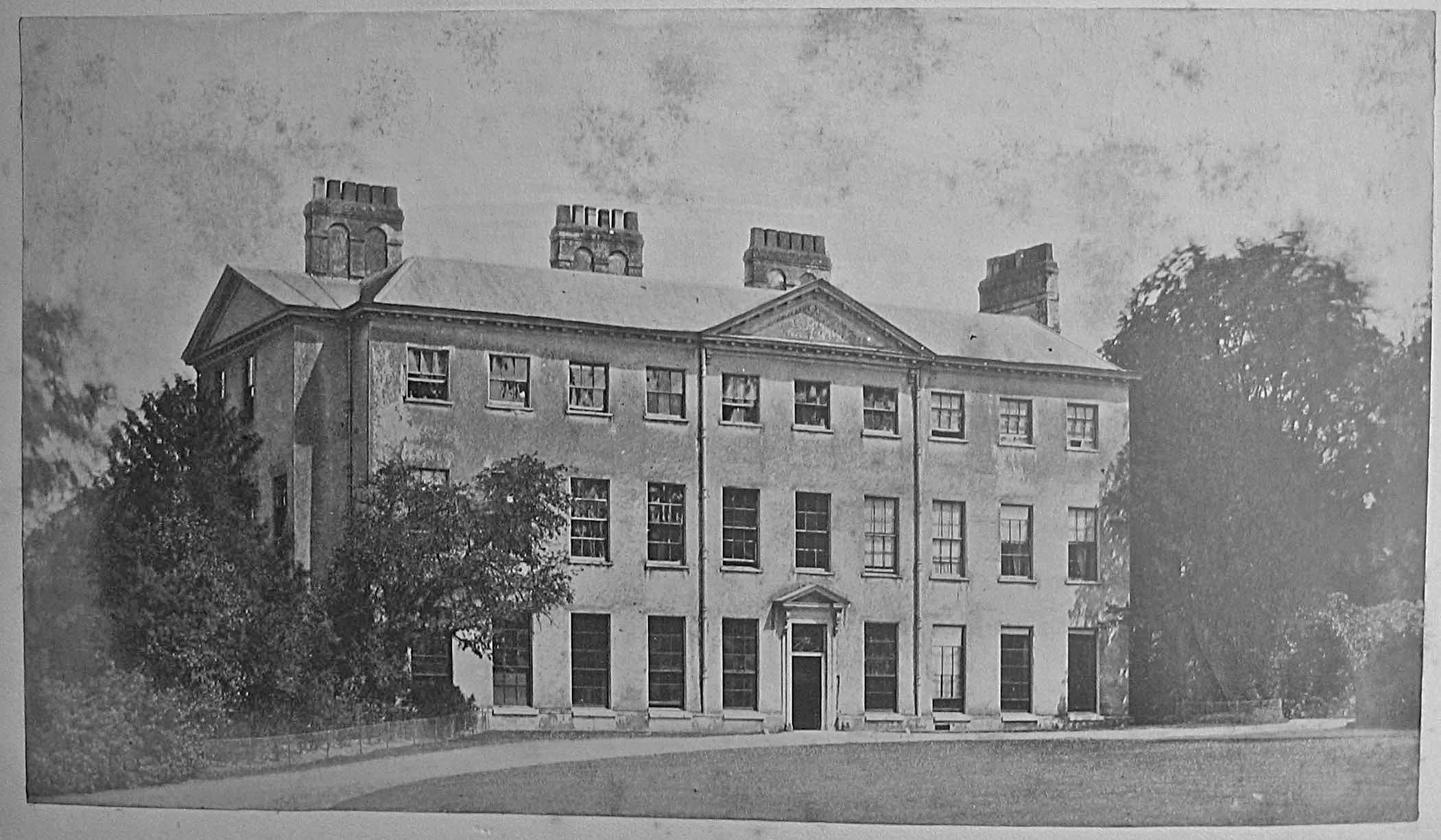
Fetcham Park (west) c.1876
Thomas Cubitt worked on the house in 1837, when he came ‘down to take possession of Fetcham for 3 or 4 months’.
John Barnard Hankey inherited Fetcham Park in 1875, three years after his marriage and when he was aged thirty. He immediately commissioned a leading architect to undertake a complete facelift and refurbishment of the house, altering it from ‘an attractive Queen Anne/early Georgian mansion to a very inappropriate simulation of a French chateau’. This work was most likely financed from the building leases in Clapham which he and his father had sold in the preceding year.
The family evidently had to move out of Fetcham Park during the rebuilding works, and in 1881 Barnard and Fanny were recorded in the census at Eaton House, London with their four children and thirteen servants. A fifth child was born later that year, and a sixth in 1886, but Fanny died on 19 Dec 1886 and was buried on 23 Dec at Fetcham. ‘She died quite suddenly a fortnight after her confinement. She was going on perfectly well.’
John Barnard Hankey took a second wife a little over a year later, being married on 28 April 1888 at Fetcham to Ellen Gertrude Moon (1860-1946). She was the daughter of Rev Sir Edward Graham Moon Bt., the rector of Fetcham for fifty years, whose father had been lord mayor of London in 1854.
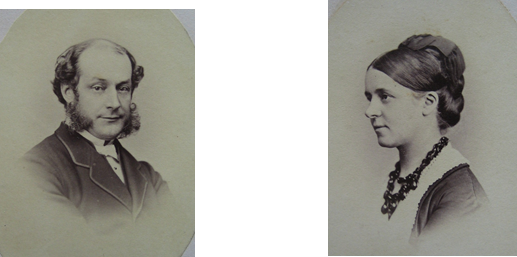
Rev Sir Edward Graham Moon Bt Lady (Ellen) Moon
Rector of Fetcham
Barnard and Ellen had three children:
Thomas Barnard |
1889-1969 |
m 1927 Ethel Thomson; issue (see below) |
Arthur Barnard |
1890-1974 |
m 1919 Cecilia Winifred Mosley; issue |
Miriam Barnard |
1892-1980 |
m 1911 Frederick G Colman (of the mustard family) (div); 1882-1969 |
m 1922 Lt-Col Guy de Hoghton DSO, MC (div 1938) |
||
m 1947 Alfred Bovill |
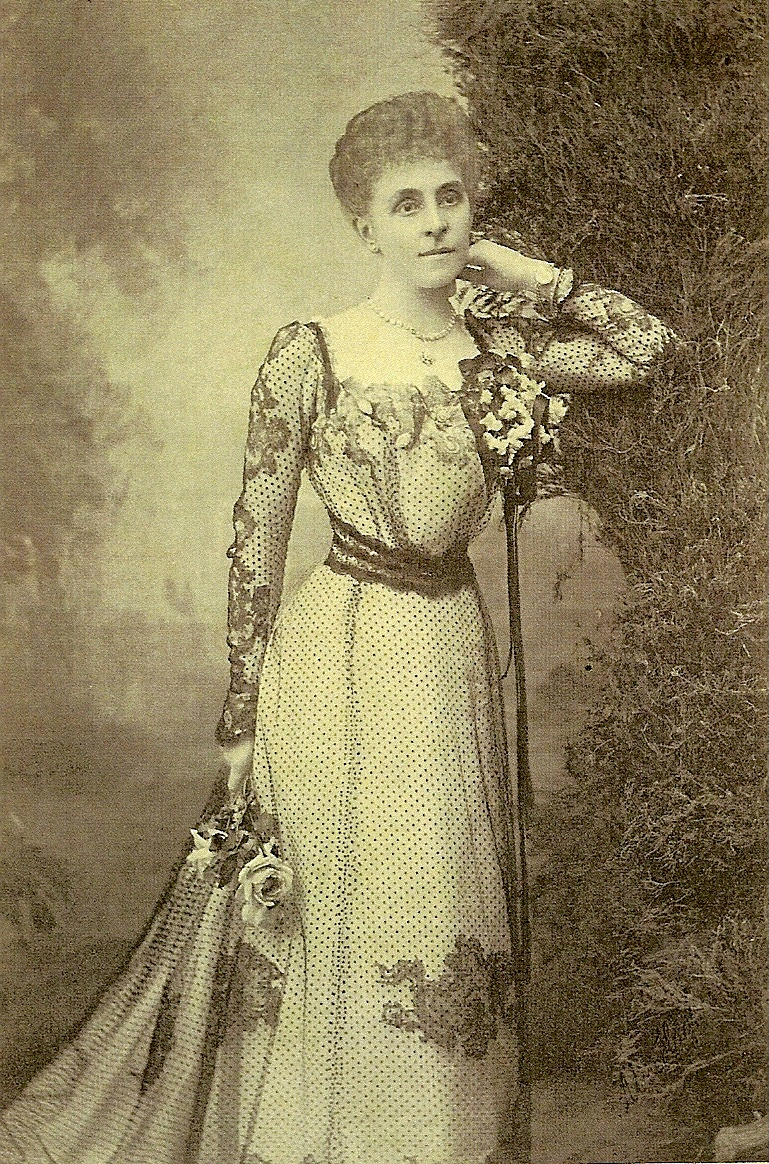
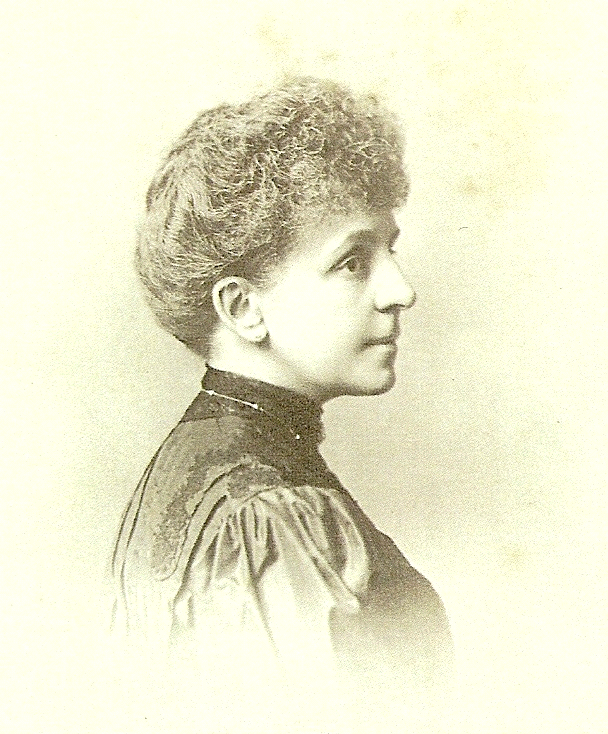
Barnard’s five sons all went to Eton (as did he and his father and grandfather) and the four eldest served with great distinction in the war, all surviving. Of his five uncles, two were naval captains and one was a lieutenant-general.
‘After leaving College Mr Hankey entered actively into the judicial and political life of Surrey. In 1879 he became High Sheriff of the County and for some years acted as a Justice of the Peace. In the latter capacity he has won high renown for his shrewd common sense and thorough legal knowledge. A staunch Conservative, Mr Hankey has ever been a believer in Tariff Reform.’
Barnard’s interests were centred largely around sport. He was master of the Surrey Union foxhounds from 1876 to 1882, giving ‘the greatest satisfaction, as his all-round sporting proclivities made him a general favourite’. Polo was played at Fetcham Park from 1892, when Barnard placed at the disposal of the Fetcham Park Club ‘a full-sized and very picturesque ground in his park.’ The shooting at Fetcham was the occasion for house parties, and the racing at the nearby courses at Epsom, Sandown and Ascot was the occasion for further entertainment. He would often take grouse shooting and fishing in Scotland, bringing with him a substantial staff to look after his family and guests.
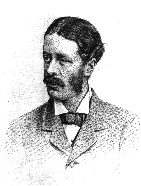
John Barnard Hankey
The following account gives a flavour of life at Fetcham at the end of the nineteenth century. It was written by one of John Barnard Hankey’s footmen, Charles Cooper.
‘I went to Fetcham Park at the beginning of August, 1895, and found they kept a big staff, twenty all told. I had no time to get to know anyone well or get settled down, before we packed up for Scotland, Mr. Hankey having taken Sir William Gordon Cumming’s place, Dallas Lodge, Forres, for the grouse shooting. Judge of my surprise when I was informed that I was to travel with the head and second coachman. We were to go by sea, taking with us two pairs of carriage horses, one old mare for the game cart, and a still older Scotch hill pony’.
‘We travelled by the Aberdeen Steam Navigation Co.’s Ban Righ. We were all sorry when the time came for us to disembark. We led the horses from the harbour to the station and boxed them for Forres. On arrival at Forres I learnt with dismay that it was eight miles to Dallas Lodge. At length we sighted the Lodge. Mr Hankey was leaning over a wall watching us arrive.’
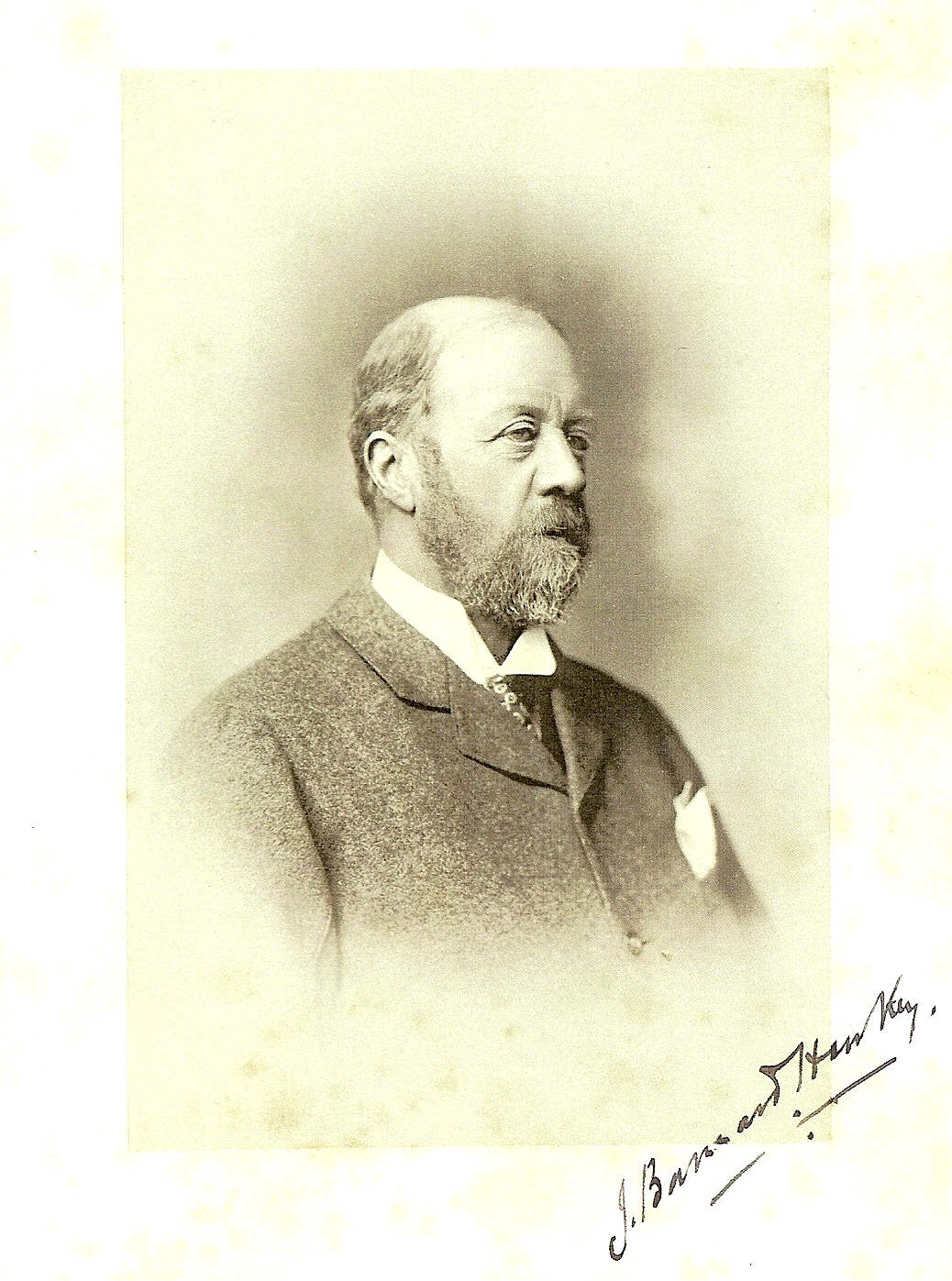
Every other day, after the flasks were filled and everybody had one, the butler and myself would go off and join the beaters in the grouse drives. Then at mid-day came the unloading of the game-cart that had followed with the luncheon baskets, etc. The Beat nearest the Lodge was called the thirty thousand acres; this we did for the first day’s shoot, finishing up four miles from home. The brake with pair of horses was sent to convey the guns, whilst we with the Gillies walked back.
The first footman and second coachman went the next day; the two of us who were left at home did all that there was to be done, such as the breakfast, luncheon for those ladies who stayed at home, prepare a substantial tea and lay up for dinner; we were also responsible for the luncheon baskets being properly packed.
Getting back to Fetcham Park seemed like going into a fresh place; having only been there three days before going to Scotland, I had scarcely met the rest of my fellow servants.
We had several house parties during the shooting season, there being plenty of pheasants, partridges, and hares in abundance; the Glebe lands in front of the house was a sanctuary for the latter.
During the hunting season, Capt. George Hankey, Mr Edward (now Colonel of the Worcestershire Regiment), and three young ladies used to ride. It was always a great day when the Hounds met there, the butler and us two men handing round the stirrup-cup of wines and liqueurs, sandwiches, cakes, etc.; whilst for the villagers and others following on foot there was plenty of beer, bread and cheese.
During the racing season a lot of entertaining was done, especially for the Spring and Derby meetings at Epsom, and all meetings at Sandown Park. These two places of course are within easy driving distance, so they used a bus and pair of horses, the luncheon baskets and ice-pail for the champagne being packed on the top.
At Epsom Mr. Hankey used to take a box on the Grand Stand; behind these boxes in the corridor, tables were placed for serving luncheon; this was very convenient for the gentry and a great boon to those responsible, for no unauthorised person was allowed on the stand, so that it was quite safe to turn one’s back without fear of losing anything.
Mr. Hankey called me into the box to see the Irish horse, Galtee More win the Derby in 1897 by umpteen lengths. I should say there never was a greater certainty; it also won the Two Thousand Guineas and the St. Leger.
For Ascot Races Mr. Hankey and five other gentlemen took a house there for the week, each one taking a manservant; a cook and housemaid being retained. On one occasion I went with Mr. Hankey to stay with Mr. Harry Hansard at Romsey for the Bibury Club race meeting at Stockbridge.
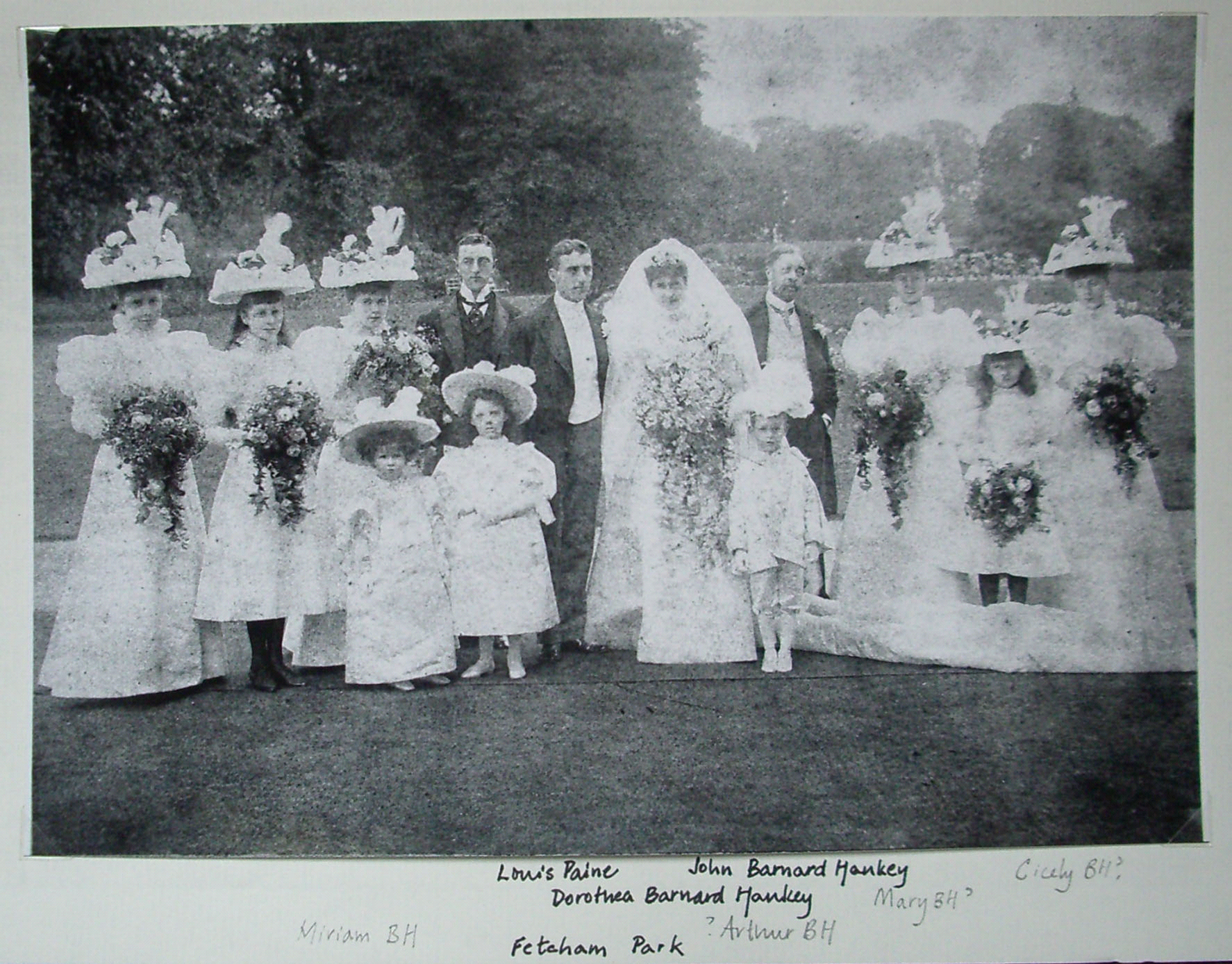
Dorothea Barnard Hankey married Louis Paine in 1896
In 1896 Miss [Dorothea] Hankey the eldest daughter married Mr. Louis Paine. She was noted for her extremely good looks and most charming manner, whilst he was a fine horseman and splendid polo player. The wedding presents were numerous and costly. These were displayed in the billiard room, being guarded at night by us footmen.
The day of the wedding will always be remembered by me. There was no stint of anything, champagne was given to all. The dining room was used for the wedding breakfast, the table being extended to its full length to form a buffet. This had all been cleared away and the room left tidy by the caterers.
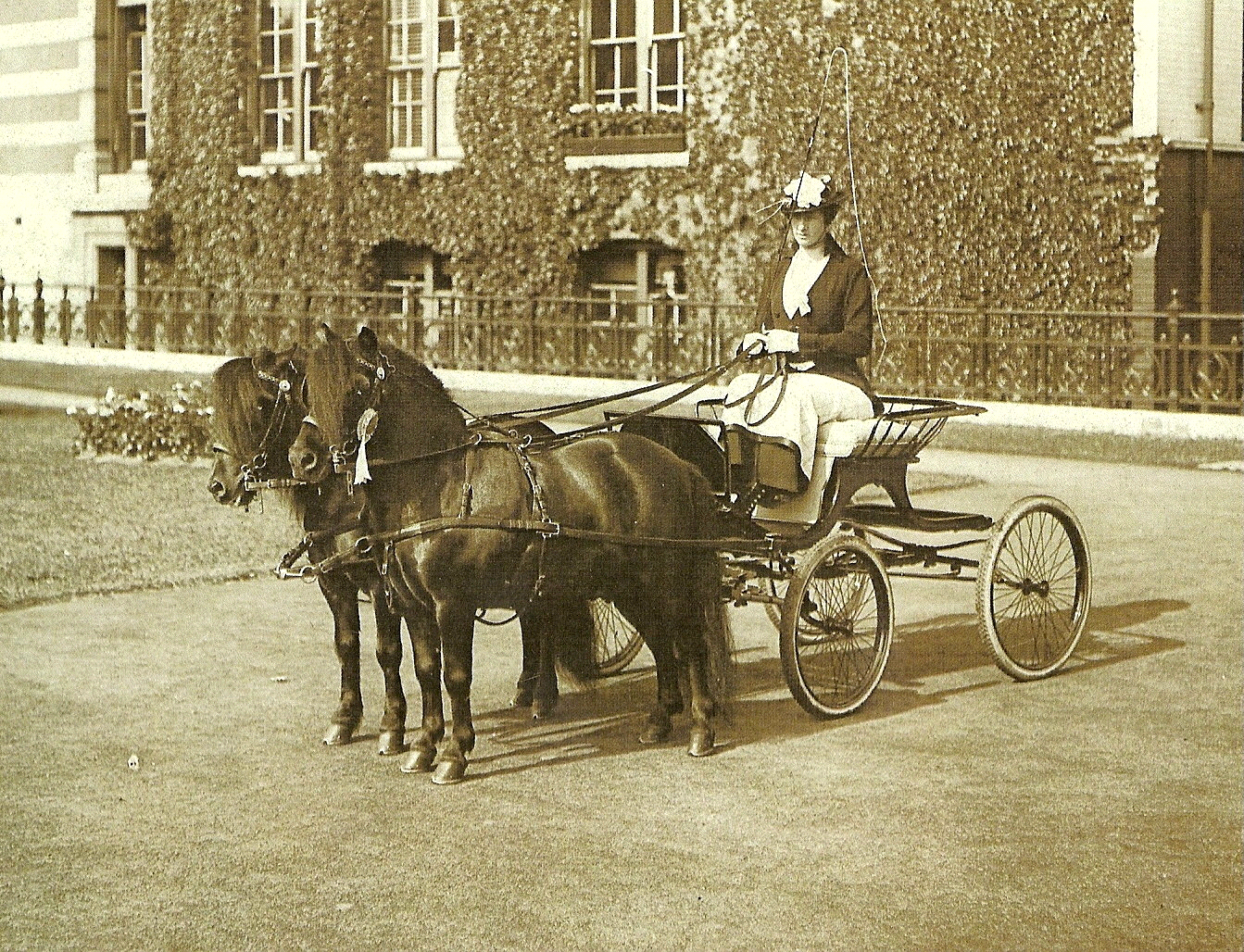
Miriam Barnard Hankey, said to be the talk of the county
when she drove her Shetlands at the Surrey County Show
I remember one Monday morning Mr. Hankey and the second daughter Miss Andalusia were going to London, the brougham being ordered for nine o’clock. When the carriage came to the door, Mr. Hankey stepped in and drove off to the station; we then had to send round to the stables for the Pony Cart to take Miss Andalusia.
Mr. Edward Hankey, whom I valeted, was a great favourite with us all, and very good natured. When he received his commission to join the Worcestershire Regiment at Malta in 1895, I had to pack up for him; he gave me several suits of clothes, cigars, cigarettes, pipes and tobacco. I had the honour of later being invited down to Fetcham, to see him in bed, recovering from a very severe wound received during the South African War..
The summer passing away we once more turned our thoughts to Scotland, again to Dallas lodge by rail, sea and horseback. Our next trip to Scotland was to Knockando on the Spey, which Mr. Hankey took from Mr. Grant of Elchies for the shooting and fishing. I went up with him in May for the spring fishing, staying at the Aberlour Hotel, Aberlour, about four miles from the Lodge. Mr. Hankey and myself were most days up the river, a short journey by train, taking our lunch with us. Several nice fish were caught. One day he forgot his tobacco pouch, so I gave him mine. ‘What are you going to do,’ he said. ‘Borrow some of the keeper’s twist’ I replied. He laughed and walked away. I got my pouch back at night, with a pound tin of Lambert & Butler’s Birdseye. He was a great smoker, an excellent shot and a thorough English gentleman.
We returned to Fetcham until August, then the whole lot of us went up to Knockando. This was a nice little house; an iron bungalow stood at the back containing four bedrooms for single gentlemen. Sport was good, excellent bags of grouse, partridges and black game were made and the fishing results gave satisfaction.
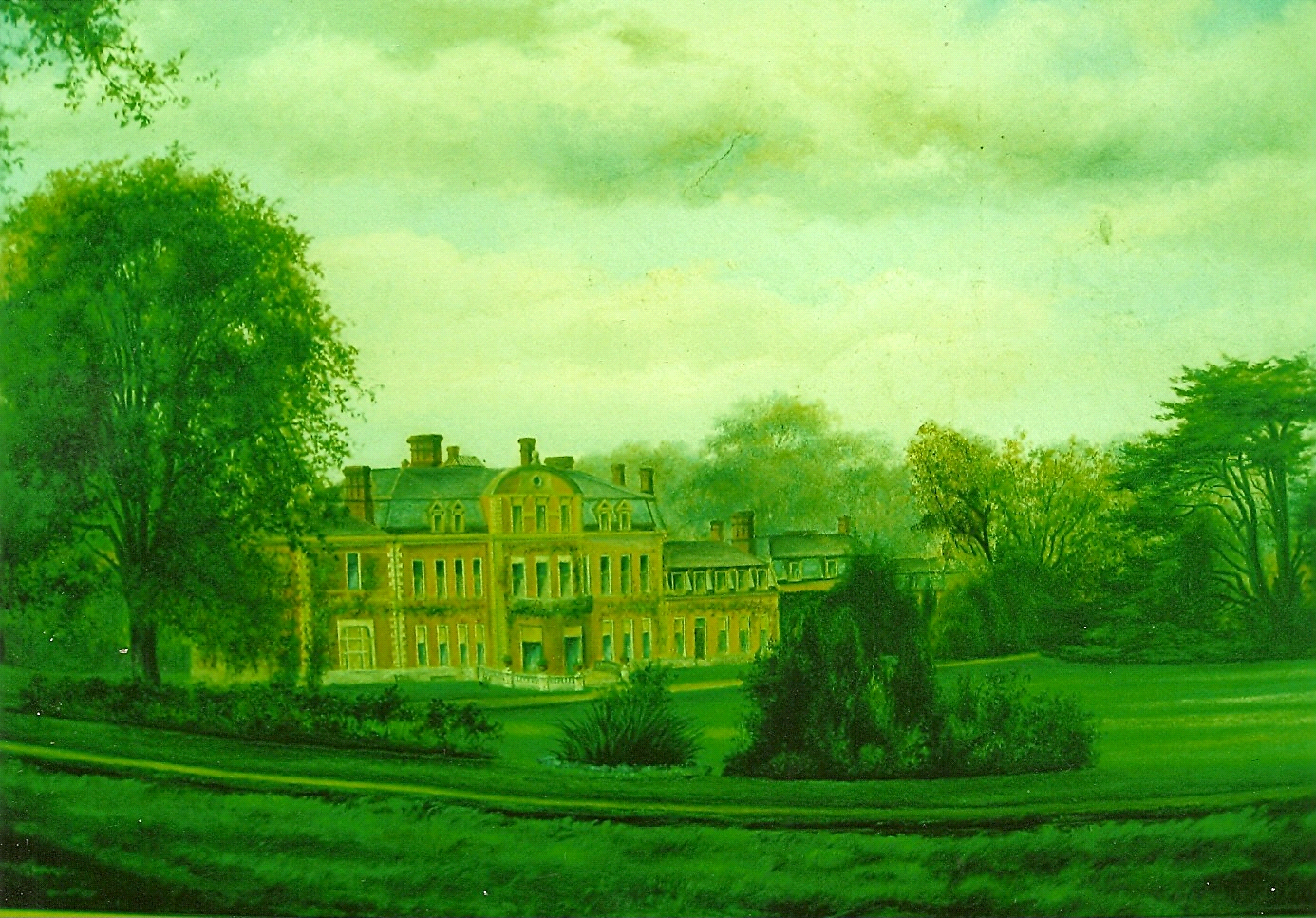
John Barnard Hankeys mansion at Fetcham was set in an extensive park with fine trees
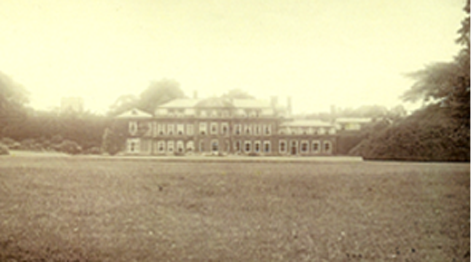
Fetcham Park, North East side,
in the time of John Barnard Hankey
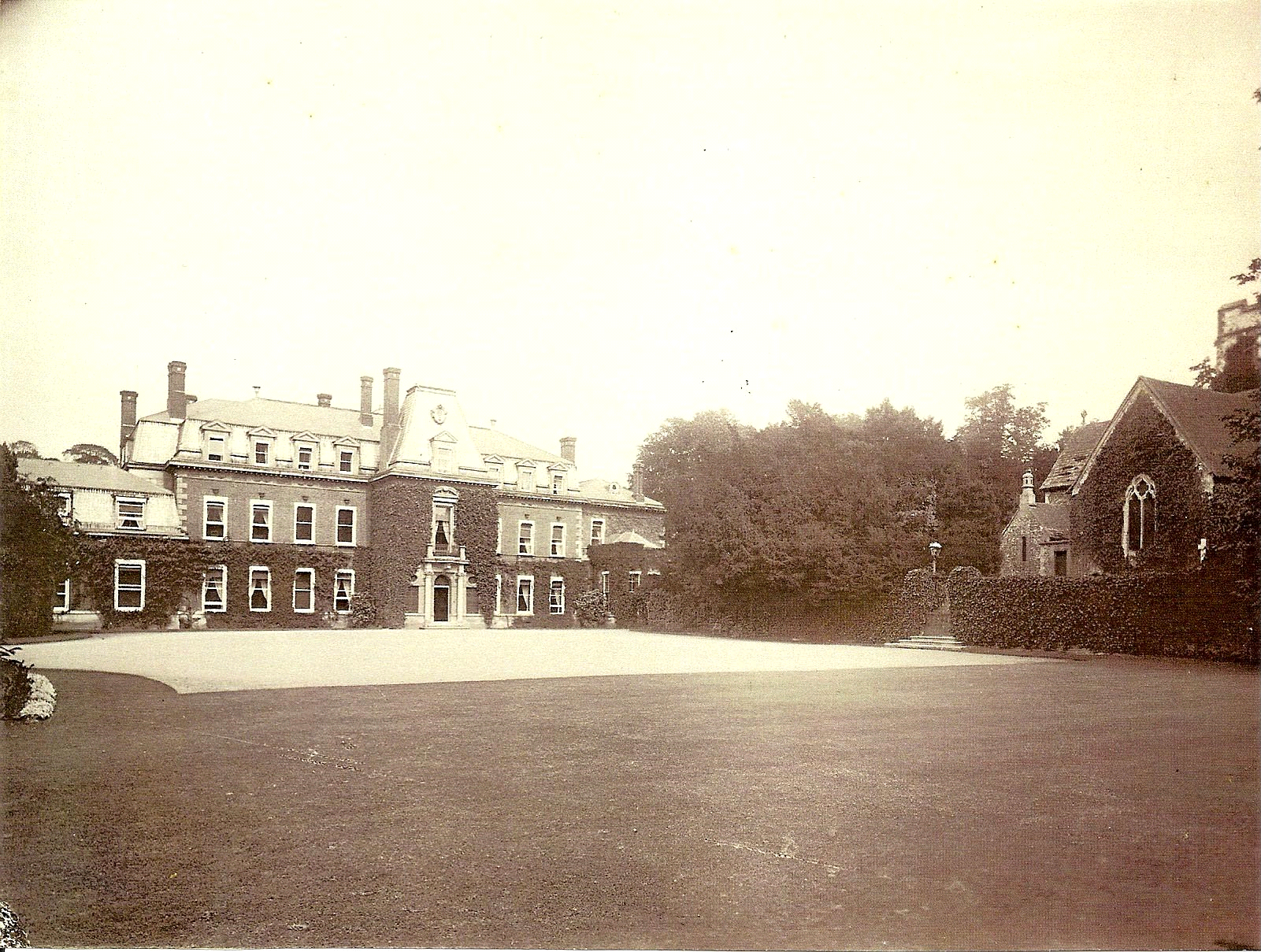
Fetcham Park - South West approach, with Fetcham Church,
in the time of John Barnard Hankey
Barnard’s thirty-nine year ownership of Fetcham Park coincided with the peak of Victorian and Edwardian prosperity. He maintained a household of substantial size, and a standard of living which was high, even by the standards of the day. It was fortunate that his very substantial inheritance (and realization of property assets) was able to support his family of nine children, his estate and household, sporting activities, house parties and entertainment. But income tax and death duties had already arrived, and the life-style of the rich was abruptly curtailed for ever with the declaration of war in 1914.
Barnard died in May of that year, and it was perhaps fortunate that he did not live to see the collapse of his world around him, and the sale of Fetcham Park and its remaining land within eleven years.
John Barnard Hankey died on 24 May 1914 and was buried at Fetcham; his widow died on 14 Apr 1946.
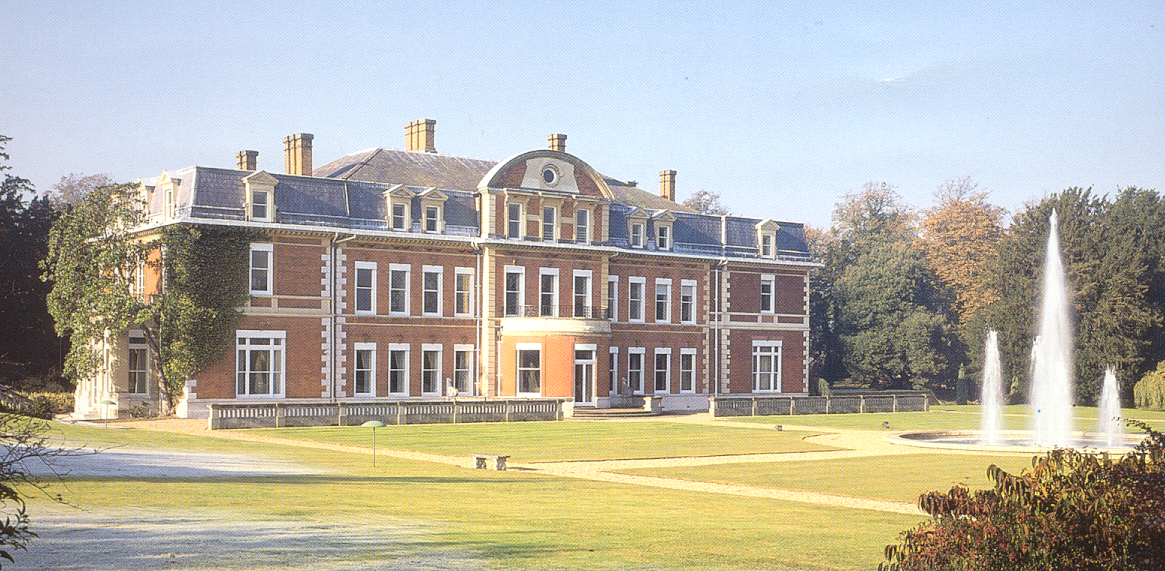
Fetcham Park, North East side, with symmetrical modifications to the wings c.1982
The Properties at Fetcham, Clapham and the City
The Fetcham Park estate comprised 1326 acres when purchased by Thomas Hankey in 1789, and by 1851 about 700 acres remained in the possession of his son Barnard Hankey the elder. Much of the remainder passed to Barnard Hankey’s sons, and over the years this land was gradually sold out of the Hankey family, until only about 200 acres remained. In 1924 George Frederick Barnard Hankey sold most (149 acres) of the remaining land for building development, and in 1925 the mansion of Fetcham Park itself.
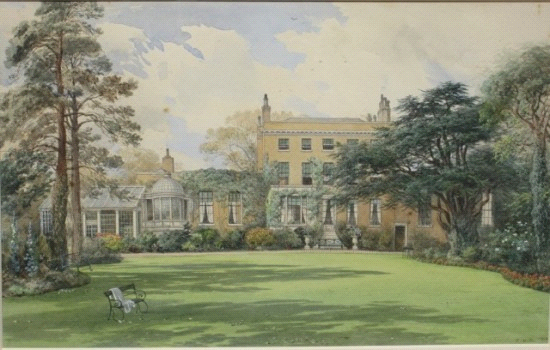
Eagle House, Clapham Common
In 1872 George James Barnard Hankey owned Eagle House, a large mansion on Clapham Common for many years in the Hankey family. In 1874 (shortly before George’s death) he and his son sold building leases on land in Bromfelde Road, Clapham, possibly the fields left by Sir Henry Hankey in 1737. Eagle House had been ‘built in 1773 by Mr Benjamin Bond’. Bond leased the site, about 15 acres, from a local landowner, Sir Thomas Hankey.
In February 1893, premises in Change Alley were advertised for sale. The buildings were very old and consisted of offices, one or two shops and the King’s Arms Tavern. The company was able to buy this rambling property for £71,000. ... Well before the end of the eighteenth century the King’s Arms was no longer a tavern and was used entirely as a place suitable for meetings. It passed eventually into the hands of the Hankey family of Fetcham Park, and it was a member of that family, John Barnard Hankey, who sold the freehold to the Commercial Union in 1893.
The Kings Arms Tavern must have been the same property known as Jonathan’s Coffee House in Exchange Alley, which was left by Sir Henry Hankey in 1737 (who possibly inherited it in 1728 from his father in law Joseph Chaplin, a wine merchant). In 1773 Joseph Chaplin Hankey owned a two-seventh share in the freehold of the Kings Arms Tavern in Exchange Alley and Cornhill, which he left to Thomas Hankey, Stephen Hall and Samuel Troughton upon trust for sale. This share must have been sold within the Hankey family, who retained it until its sale in 1893.
John Barnard Hankey evidently had an interest in Canadian property, and from 1909 to 1912 owned the Fairmont Hot Springs ranch and roadhouse in British Columbia.